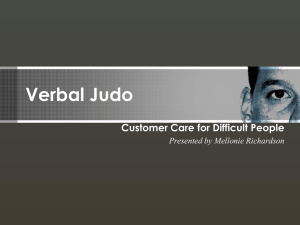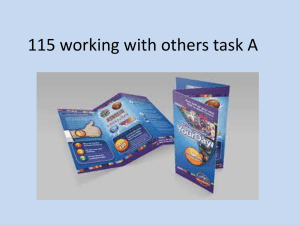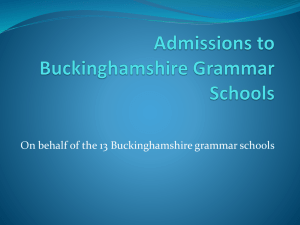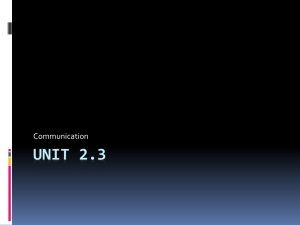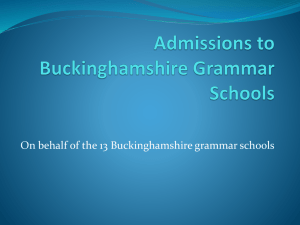Sample Junior Oral Language Programme to address identified
advertisement
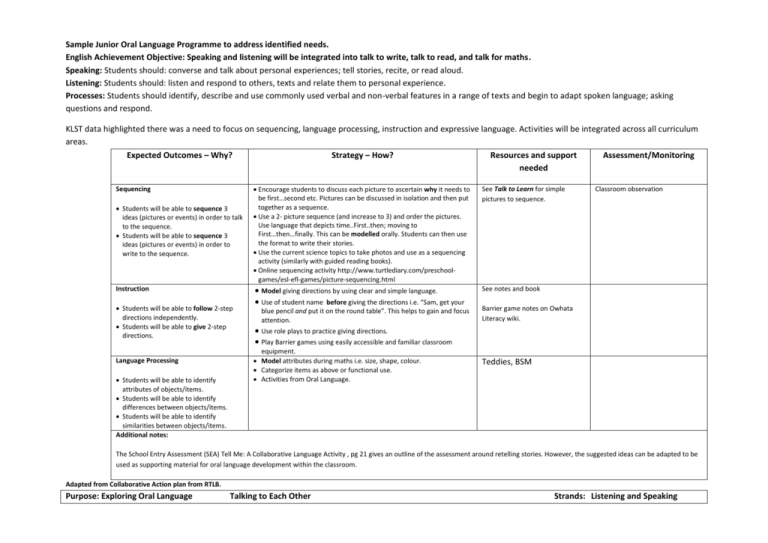
Sample Junior Oral Language Programme to address identified needs. English Achievement Objective: Speaking and listening will be integrated into talk to write, talk to read, and talk for maths. Speaking: Students should: converse and talk about personal experiences; tell stories, recite, or read aloud. Listening: Students should: listen and respond to others, texts and relate them to personal experience. Processes: Students should identify, describe and use commonly used verbal and non-verbal features in a range of texts and begin to adapt spoken language; asking questions and respond. KLST data highlighted there was a need to focus on sequencing, language processing, instruction and expressive language. Activities will be integrated across all curriculum areas. Resources and support Expected Outcomes – Why? Strategy – How? Assessment/Monitoring needed Sequencing Students will be able to sequence 3 ideas (pictures or events) in order to talk to the sequence. Students will be able to sequence 3 ideas (pictures or events) in order to write to the sequence. Instruction Students will be able to follow 2-step directions independently. Students will be able to give 2-step directions. Language Processing Students will be able to identify attributes of objects/items. Students will be able to identify differences between objects/items. Students will be able to identify similarities between objects/items. Additional notes: Encourage students to discuss each picture to ascertain why it needs to be first…second etc. Pictures can be discussed in isolation and then put together as a sequence. Use a 2- picture sequence (and increase to 3) and order the pictures. Use language that depicts time..First..then; moving to First…then…finally. This can be modelled orally. Students can then use the format to write their stories. Use the current science topics to take photos and use as a sequencing activity (similarly with guided reading books). Online sequencing activity http://www.turtlediary.com/preschoolgames/esl-efl-games/picture-sequencing.html See Talk to Learn for simple pictures to sequence. Model giving directions by using clear and simple language. Use of student name before giving the directions i.e. “Sam, get your See notes and book blue pencil and put it on the round table”. This helps to gain and focus attention. Classroom observation Barrier game notes on Owhata Literacy wiki. Use role plays to practice giving directions. Play Barrier games using easily accessible and familiar classroom equipment. Model attributes during maths i.e. size, shape, colour. Categorize items as above or functional use. Activities from Oral Language. Teddies, BSM The School Entry Assessment (SEA) Tell Me: A Collaborative Language Activity , pg 21 gives an outline of the assessment around retelling stories. However, the suggested ideas can be adapted to be used as supporting material for oral language development within the classroom. Adapted from Collaborative Action plan from RTLB. Purpose: Exploring Oral Language Talking to Each Other Strands: Listening and Speaking Levels Possible Contexts 1 and 2 3 and 4 5 and 6 7 and 8 Everyday observations and monitoring in: Classroom Playground Discussion groups Conferences Conversations Activity groups Study of oral language text types. Topic study, such as relating to others. Role play of characters in history. Study of a shared novel. Book review. A study of examples of how speakers adapt to audience and purpose in conversations. A study of how spoken conversations differ from their written forms. Suggested Activities Students’ conversations are taped and assessed against developmental criteria. Students hear, and are encouraged to speak in conversations. Students’ home language is valued as a starting point for learning the conventions for talking to each other. Teacher and students examine direct speech in cartoon and comic texts. They insert dialogue in wordless texts. In whole class or discussion groups, teachers and students read a text and choose a character. They: Make mind maps and then a cartoon strip with direct speech; Retell the same event in another form; Compare the language features and construction. Following modelling, students record a person telling an anecdote. The anecdote is also written, and the two versions are compared. Comparing oral and written language: Teacher and students listen to a recording of someone relating an event or experience. They transcribe part of the text. The speaker records the same event in writing. The texts are compared and differences analysed. Teacher and students listen to each other in conversation, noting the use of verbal and non verbal features. Terminology Greetings. Response. Feedback. Minimal responses. Turn-taking. Verbal and non-verbal cues. Verbal and visual (non-verbal) cues. Discourse markers. Intonation. Responses. Oral language at a distance: Students volunteer for telephonists’ roles. Cards offer other students a range of possible callers. Telephonists take phone calls and respond to callers such as friend, DJ, sports celebrity, prime minister, principal, bank manager. Peers note changes in language structure, delivery, and content in different responses and examine how speakers adapt to audience and purpose. Standard and vernacular. Politeness forms. All previous terminology. Purpose: Exploring Oral Language In discussion groups for topics, maths Possible Contexts activities, developmental activities, sharing written work, trips and special occasions. In oral focus time. Suggested Activities In discussion groups: Teacher models listening skills and behaviours. Students chart listening behaviours. In groups of 3 – listener, speaker, motivator – they practise listening behaviours, change roles, and repeat activity. Teacher models and students use oral language conventions. They work in groups taking roles of speaker, Discourse markers. Repetition. Grammatical structures. All previous terminology. Strands: Listening and Speaking Study of different genres, such as myths and legends; storytelling; fiction and non-fiction. Study of local community. Oral language focus, such as: The language of persuasion; Adapting language to the audience and purpose. Students study a range of myths, legends, tales and local anecdotes, exploring language features. They: Discuss the conventions of storytelling; Create and present orally a myth or legend of their own, telling about a local event or geographic feature and describing and justifying language choices. Students listen to a range of other oral Teacher and students explore and discuss appropriateness and style in a range of oral presentations such as: Groups select an audience – principal, peer, parent. They prepare and present an argument proposing an event like an end of exam party, showing understanding of language choices appropriate to the purpose and audience. Oral language focus, such as: Studey of a them; Study of register and slang; The nature and causes of language changes. Teachers and students listen to, read, and view texts around a theme, such as war. They: Describe, analyse and evaluate language features, noting words and phrases particular to the theme or context; Study another context, such as sport, identifying and comparing slang, jargon, register and language features in that theme. Terminology recorder, motivator, listener, change roles and repeat activity. texts. They: Compare each with the conventions of story telling; Present the myth in another text type, such as a report. They are assessed by peers and assess themselves against agreed criteria. Repeat the study in a new context, such as pop music lyrics in the 20th century. Verbal and visual (non-verbal) cues. Questioning, turn taking, greeting, intonation. Verbal and visual (non-verbal) cues, intonation, appropriateness of verbal presentation. Intonation. Verbal and non verbal features. Denotation and connotation. Vernacular. Intonation. Rhythm. Verbal and non verbal features. Register. Slang. Standard and vernacular.
